Twigs and Branches - 2022 November - December.
A web of present and past events
These short articles are written to highlight connections of the plants, history and lore of the Eloise Butler Wildflower Garden with different time frames or outside connections. A web of intersections.
The origin of winter bird feeding at the Garden
Only a few people may remember the origins of bird feeding in Theodore Wirth Park and in the Eloise Butler Wildflower Garden and Bird Sanctuary, starting with a single bird feeding station in the area of the Hemlock grove of the Wildflower Garden on Thanksgiving Day 1932. First, near where the back gate now stands, then inside both back and front gates and of course in many places around the Garden office and shelter. That 1932 station was started by one woman, Miss Lulu May Aler, when Eloise Butler was still Curator.
Every day in winter she walked a mile from her home on Newton Avenue, or from her work place on Glenwood, to put out the feed, donated by Garden clubs, Audubon members and other individuals. She missed on the day of the Armistice blizzard, but shoveled her way through the following day. People saved their squash, cantaloupe and sunflower seeds to contribute in the winter feeding.
She was active in the Minneapolis Audubon Society, was president of the Society in the 1940s, gave talks on birds to many groups, was an expert photographer of birds and as far as we know, she was the first person to give weekly morning bird walks in Wirth Park.
In her other life she was the superintendent of the Minneapolis Maternity Hospital at 2215 Glenwood Ave. from the 1920s into the late 1930s. She was close friends with Martha Crone who was Curator of the Wild Flower Garden during this period. In the late 1950s she turned over the maintenance of the feeding stations to the Minneapolis Bird Club and moved to Indiana where in 1959 she married Charles Yelick, who was a fellow birder who frequently visited the Garden and hepled her with the early feeding station. More details on the feeding stations and Miss Aler at this link.
Below: The main bird feeding station at the Garden in Wirth Park circa 1936.

Moosewood?
Why would a tree, special to our area, be called “Moosewood” or “Goosefoot” for that matter?
It’s a question of design and circumstance. The Garden’s Striped Maple (Acer pennsylvanicum) is known by those additional names for reasons explained here. While it is not native to Minnesota, Eloise Butler wanted the species in the Garden in 1909 and the Park Board was growing them in their nursery for local introduction. Eloise was fond of the tree as it is plentiful in her native Maine.
There is a nice young specimen near guidebook station 4 at the Garden and a much larger one near station 13 that is on the Minneapolis Heritage Tree List.
The green bark is broken into furrows showing a pale under-layer of vertical stripes; there are yellow bell-like flowers in the spring, and rosy down-covered young leaves, which when mature resemble the foot of a goose.
As to Moosewood - in 1876 Susan Fenimore Cooper wrote the best explanation by explaning how moose use the tree:
“With their one pendulous lip they would grasp and pull down the branches, and holding them between their fore-legs, eat off all the twigs, or with the hard pad on the roof of the mouth placed against the trunk of the tree, they would scrape upwards with their sharp gouge-like teeth, and soon strip away every shred of bark from the root to the height of seven or eight feet above. Of all the trees of the forest they fancied most the bark of the graceful, airy striped-maple, called moose-wood from this fact, a tree found everywhere among the Otsego hills.”
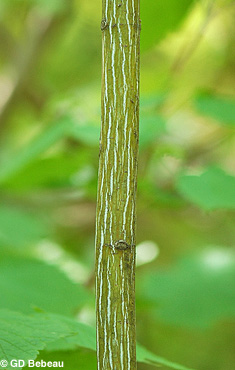
Francois Michaux wrote in his 3 volume North American Sylva of 1817-19:
“The inferior size of Moose Wood forbids its use in any kind of carpentry, but as it is white and fine grained, the cabinet makers of Halifax employ it instead of Holly, which does not grow in so northern a climate, for forming the white lines with which they inlay Mahogany. Its principal advantage consists in furnishing the inhabitants, at the close of winter, when their forage is exhausted, a resource for sustaining their cattle, till the advancing season has renewed the herbage. As soon as the buds begin to swell, the famished horses and neat cattle are turned loose into the woods, to browse on the young shoots, which they crop with avidity. Poor as this resource may appear, it is not wholly inadequate, since the twigs are tender, and full of saccharine juice."
With the milder winters coming to Minnesota, perhaps Striped Maple, aka Moosewood, may become further established. Link to our information sheet on Moosewood.
Bumblebees Use Tools
In the November Twigs and Branches we demonstrated bee play activity. Dr. Lars Chittka has another experiment that shows the ability of the tiny brains to learn to use a tool.
It was already known that insects can solve some cognitive tasks. Many times those tasks are similar to their foraging techniques. But what about a task that they do not perform for foraging or for any other purpose - such as using a tool.
Among several experiments that demonstrated the ability here is one example that requires a bee to pull a string to obtain nectar.
Watch the short video and believe. Furthermore - other introduced bees observing the behavior were able to duplicate the activity. Here is a pdf of the research article.
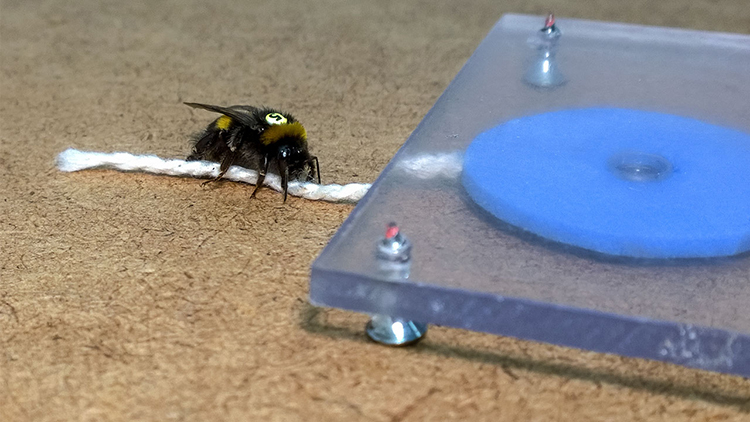
The main researchers of this work are from of Queen Mary University, London. Dr. Chittka has spent his entire career studying the habit of bees.
You can revisit last months bee's having fun story at this link.
The Svalbard Global Seed Vault
Is it safe during global warming?

Svalbard, located on the Norwegian island of Spitsbergen in the remote Arctic Svalbard archipelago, is a secure backup facility for the world's crop diversity. The Seed Vault provides long-term storage of duplicates of seeds conserved in genebanks around the world. This provides security of the world's food supply against the loss of seeds in genebanks due to mismanagement, accident, equipment failures, funding cuts, war, sabotage, disease and natural disasters. As of June 2021, the Seed Vault conserves 1,081,026 distinct crop samples, representing more than 13,000 years of agricultural history.
Seeds are stored by the agencies of world governments in secured boxes and can only be removed by the original owners. Syria recently made a withdrawal of their deposit to replenish the Syrian seed bank destroyed during the recent war.
There are three separated vaults, but only one is in use so far. Capacity is expected to be 4.5 million seed varieties.
The United States uses Svalbard as a backup to the other seed repositories in this country and has deposited almost 70,000 varieties with another 19,000 pending as of 2020. {per USDA}.
But is the vault itself in danger from warming climate? The vault is built into a mountainside, well above any danger from rising sea levels. It was designed with an expected life of 200 years. Deep in the permafrost, the seeds are maintained at a temperature of -18 degrees Celsius. Several years ago melt water penetrated the entrance but never got close the seed vaults which are much deeper and colder, but the Norwegian Government, which has paid for the entire facility, made repair adjustments to forestall such a future event - but time will tell what may happen in this uncertain future!
Link to Croptrust website about the vault
Below: Inside the Svalbard Seed Vault.
LINK: Take a video tour of the complex (YouTube)

Seed vault entrance photo above courtesy Wikipedia Commons - under creative commons license BY-SA-4.0.
Vault inside photo courtesy of Croptrust.
Fall Volunteer Events
The Volunteer Appreciation Event Resumes
The fall season concluded with a successful Volunteer Appreciation Event held on October 30th. This annual event had been in hibernation during the Covid outbreaks and many were appreciative of being able to attend once more. The room at Lake of Isles Lutheran Church, food and beverages were provided by the Friends, desserts by Susan Wilkins. Thanks to Pam Weiner and Melissa Hansen for organizing.
Volunteers looking happy at the Volunteer Appreciation Event - photo (l-r) Melissa Hansen, Pam Lapham, Kimberly Ishkov, Jennifer Olson.

The Friends held the very first Volunteer Appreciation Event in the summer of 1979. It was a picnic at the Garden. What happened was explained in the Fringed Gentian™:
The Board hosted a picnic for our many loyal volunteers on June 16th. Unfortunately the weather truly tried everyone's mettle. In the midst of driving rain and tornadic winds a small group of very loyal Friends assembled for a rollicking good time. An excellent feast was prepared by Marjorie Dean and Jane Hooper . . . and enjoyed by all. To the many volunteers whose intelligent caution kept them from joining our merry group . . . the BOARD does truly appreciate your hours of dedication in keeping the Martha Crone Shelter open during the season. Thank you each! Thank you all!
FIPAG events
Earlier in the month the Friends Invasive Plant Action Group (FIPAG) held three Buckthorn removal events in the Volunteer Stewardship Area outside the Garden. This area around the Maple Glen has been cleared of much of the invasive plant growth and in addition to the natives re-emerging, the Friends have purchased seeds of native plant and grasses to restore the area. Thanks to Jim Proctor and Kari Christianson for leading this group.
Hauling removed buckthorn to the disposal pile during the October FIPAG event. Photo by Bob Ambler.
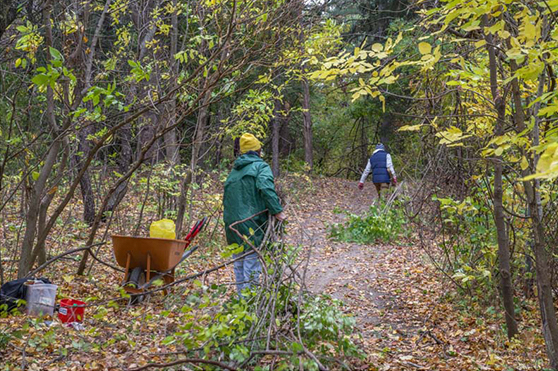
A bit of history - Plants from Isle Royale
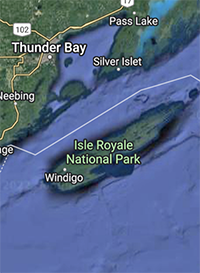
In the days of the Garden’s first two curators, Eloise Butler and Martha Crone, a number of rare plants from Isle Royale were added to the Garden. The first mention of this source was in Butler’s 1920 and 1921 Garden Log when she planted False Toadflax (Geocaulon lividum) and Devils Club (Oplopanax horridus).
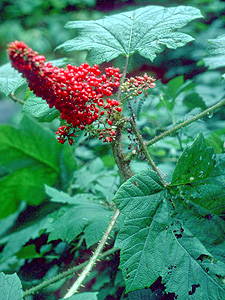
She did not list who provided these but my guess it was her friend Gertrude Cram who was listed as the source of all later plants from Isle Royale. Mrs. Cram went to Isle Royale most summers in August staying at Rock Harbor Lodge and sent back plants for the Garden. She was one of the first persons to congratulate Martha Crone on assuming the Curatorship when she wrote on April 23, 1933:
“I have heard so much of you from Miss Butler that you seem like an old acquaintance. I am so glad to hear that you are to be in her beloved garden in her stead. - I trust for more than temporarily - for I am sure it is what she would have desired.”
Most of these plants of the north were either rare or not existant in Minnesota, so they fulfilled a desire of Eloise and Martha to plant whatever may be suitable for the local habitat to see if they could grow here. Most of course, were too far south and did not survive long term, but some did last well into the 1960s.
Mrs. Cram would mail the plants back to Minneapolis from the Island. An example of her humorous writing is the following from August 8, 1933:
“By the Wednesday boat I am sending you a box of things, a funny one. It contains a sample of a number of plants of which you may or may not want more. ... This is what Miss Butler used to call a ‘surprise’ package, I am sure. The tall yellow things on top of the box is (sic), I think, Lysimachia terrestis, (Swamp Candles) which Miss Butler asked for last year. The roots go to China. I don’t think I got much, for as I was groveling in the muck among sticks and roots I couldn’t seem to feel the ends of the ones I was blindly following.”
A list of the various plants from Isle Royale sent to the Garden over the years of the 1930s, other than those mentioned, includes:
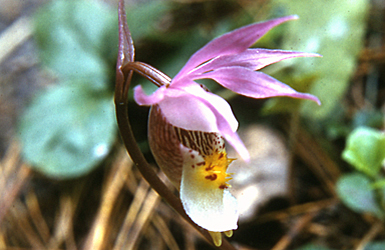
Calypso Bulbosa, Fairy Slipper Orchid
Cryptogramma acrostichoides, American Rock Brake Fern
Dryopteris fragrans, Fragrant Fern
Gaultheria hispidula, Creeping Snowberry
Geranium carolinianum, Carolina Geranium
Goodyera oblongifolia, Western Rattlesnake Plantain
Goodyera pubescens, Downy Rattlesnake Plantain
Goodyera repens, Lesser Rattlesnake Plantain
Goodyera tesselata, Checkered Rattlesnake Plantain
Listera convallarioides, Broad-lipped Twayblade
Pinguicula vulgaris, the Common Butterwort
Platanthera clavellata, Small Green Wood Orchis
Primula farinosa, Mealy Primrose
Primula mistassinica, Dwarf Primrose
Saxifraga tricuspidata, Three-toothed Saxifrage
Viburnum edule, Squash berry.


Bumblebees Bees have fun
Children play, animals are seen to play, even some birds play, but bees?? Decades of research indicate that bees will engage in play activity unrelated to any reward. The video linked here is great fun.
Bumblebees seem to have a ball rolling around plastic balls. The test of whether it is play or not is that it
(1) did not contribute to immediate survival strategies,
(2) was intrinsically rewarding,
(3) differed from functional behavior in form,
(4) was repeated but not stereotyped, and
(5) was initiated under stress-free conditions.
Below - Frames from a video of bees rolling round balls.
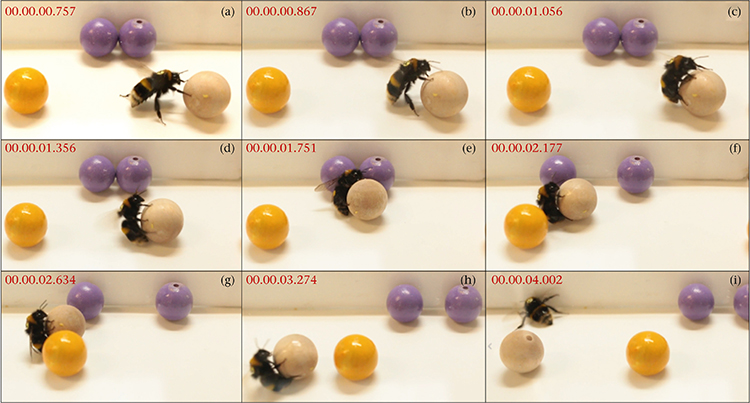
Initially the experiment was to train bees to roll a ball in order to access food, but the researchers noted that bees would roll the ball around for no apparent reason. Then they made food freely available at any time the bees wanted it and also provided access to a different chamber where they could play - many bees chose to play when they could - Furthermore - bees that had not had the early training would roll balls after observing others doing it.
This video link will show 90-seconds of their activity. The most fun part is at the end.
The main researchers of this work were Hiruni Samadi Galpayage Dona and Lars Chittka of Queen Mary University, London. Dr. Chittka has spent his entire career studying the habit of bees. He was always chagrined when colleagues in animal and bird research would report on play activity, so he decided it was time to experiment.
You can read all about the experiment setup and full results in the article recently published in Animal Behavior - link to pdf version of the study
The article and video are open access under the Creative Commons CC BY 4.0 license
(creative commons licenses)
Do bumble bees play?
Authors: Hiruni Samadi Galpayage Dona (a), Cwyn Solvi (a, b), Amelia Kowalewska (a),
Kaarle M€akela (b) , HaDi MaBouDi (c) , Lars Chittka (a)
a School of Biological and Behavioural Sciences, Queen Mary University of London, London, U.K.
b Ecology and Genetics Research Unit, University of Oulu, Oulu, Finland
c Department of Computer Science, University of Sheffield, Sheffield, U.K.
Garden plant spotlight
Wherein we link Helen of Troy, snuff, the elder Pliny and folk remedies.
Do these have any connection to a plant in the Wildflower Garden? Yes, but only when we talk about Sneezeweeds, one of which is found in Minnesota and in the Garden - Helenium autumnale, a 2 to 6 foot composite in the Aster family. There are 32 species of Helenium world wide, most with “sneezeweed” in the name. It seems that the pollen causes violent sneezing when inhaled and that powdered flower heads were used medicinally for that purpose.(1)

As to Helen, Carl Linnaeus (1707-1778) is said to have assigned the genus name Helenium for Helen of Troy but he undoubtedly was only copying the ancients since the elder Pliny wrote in his Natural History
“that helenium had its origin in the tears of Helen and the plant juice is generally thought to have been used for improving the appearance, and to maintain unimpaired the freshness of the skin in females, both of the face and of other parts of the body. Besides this, it is generally supposed that the use of it confers additional graces on the person, and ensures universal attraction.” [The plant stem contains a sweet juice.](2)
Coming forward in time to the Garden, Eloise Butler, who introduced Helenium to the Garden in 1907, wrote in September 1911:
Helenium autumnale is a glorious, late composite in rich, low land. From now on it will unfold its golden disks as long as any flower endures. It blossoms freely and often attains a height of six feet. The soft yellow ray petals are divided like those of coreopsis and surround a convex disk. The leaves are pale green, just the right shade to harmonize with the flowers. They run down on the angles of the stem, making narrow, winglike projections. If the leaves are dried and pulverized they make a titillating powder as efficacious as snuff for those who enjoy sneezing, hence its common name, sneezeweed."
"Florists cultivate the plant and have produced from it varieties. It is excellent for formal gardens on account of its height, refined color and its late, profuse blooms. It never fails to respond under transplanting. A colony of sneezeweed in the wild garden of two successive seasons which was lifted when in full bloom has repaid the labor by continuing to bloom at its appointed time.”(3)

Pliny has more to say:
“They say, too, that, taken with wine, it promotes gaiety of spirit, having, in fact, a similar effect to the nepenthes,(4).. which has been so much vaunted by Homer, as producing forgetfulness of all sorrow. The juice of this plant is remarkably sweet, and the root of it, taken fasting in water, is good for hardness of breathing; 'it is white within, and sweet. An infusion of it is taken in wine for the stings of serpents; and the plant, bruised, it is said, will kill mice.”
Isn't it great to have such a useful plant around!
Learn to identiy Sneezeweed - here's our fact sheet.
NOTES:
(1) George, Ada E.–
A Manual of Weeds–
Macmillan
1914–
(2) Pliny wrote his Natural History mostly as a compilation of information already published, so please understand that these ideas were not necessarily his but they do demonstrate the tendency of the ancient writers to list a great number of attributes to certain plants. Pliny died at Stabiae in 79CE during the eruption of Vesuvius.
(3) Published September 3, 1911, Minneapolis Sunday Tribune.
(4) Scholars believe that Homer's reference is to what today is called opium.
